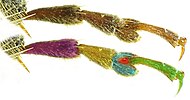Certallum ebulinum
| Certallum ebulinum | ||||||||||||
|---|---|---|---|---|---|---|---|---|---|---|---|---|

Certallum ebulinum , pair on ear of grass |
||||||||||||
| Systematics | ||||||||||||
|
||||||||||||
| Scientific name | ||||||||||||
| Certallum ebulinum | ||||||||||||
| ( Linnaeus , 1767) |
Certallum ebulinum ( synonym Cartallum ebulinum ) is a beetle from the family of the longhorn beetle and the subfamily Cerambycinae .
The generic name Cartallum is from Altgr. κάρταλλος "kártallos" derived for a "tapering basket". The species name ebulinum is derived from ( Latin ) "ebulus" and refers to the fact that the beetle can be found on the dwarf elder ( Sambucus ebulus ).
Characteristics of the beetle
The writer and coleopterologist Ernst Jünger wrote about the beetle: "Red neck, steel-blue back and to be found on Attich, the dwarf elder, therefore named after its name» ebulinum «." The brightly colored beetle reaches a length of seven to twelve millimeters. The whole body is punctured and has long, light hair isolated on it.
The head is matt black. The finely faceted eyes are only slightly edged, so that the antennae at the base are less far apart than the inner rims of the eyes on the vertex. The base of the eleven-segment antennae is noticeably large and black, the second antenna element is short and, like the rest of the antenna elements, is rust-colored (Fig. 1). In the female the antennae are almost body length, in the male only a little longer. The last link of the jaw palpation is flattened and ax-shaped (Fig. 1).
The red-colored pronotum (Fig. 2) is tied off in front and behind and lined there with black, rarely completely black (variation nigricolle ). It is at most a little longer than it is wide. On the side it has a clear hump in the middle and five less prominent calluses on the upper side. Two of these are located on each side, the fifth callus is between the two rear ones. The calluses standing one behind the other can flow together.
The elytra are metallic green or blue. Together they are wider than the pronotum. The puncture is very dense and distinctive, more noticeable than the puncture of the pronotum. The wing covers narrow only slightly towards the rear and end together rounded. The shoulders are raised. The label is semicircular.
The underside is black and has very thin whitish hairs. The first sternite of the abdomen (Fig. 3, tinted blue) is very long, almost as long as the following abdominal sternites together. The two following sternites are long golden-yellow tomentose in the female (Fig. 4). The thighs are stalked and thickened club-shaped. The tarsi are only apparently four-limbed, as the fourth tarsal is hidden between the lobed extensions of the third tarsal (Fig. 5).
biology
The larvae develop in the stems of various cruciferous vegetables ( Raphanus , Erysimum , Sisymbrium and others), and probably also in the roots and stems of plants from other families ( mint and umbelliferae ). The adults can be found on flowers from April to July.
distribution
Certallum ebulinum is widened with gaps around the Mediterranean (circummediterran). To the west the range extends over North Africa , Portugal , Spain , France , Italy and some associated islands, in the east the species occurs in southern Russia and the Ukraine . Also, the species is reported from Greece , Cyprus , Turkey, the Middle East and some Eastern Mediterranean islands. The species becomes rarer towards the north. Only old and unrecognized find reports are available from Germany . The beetle is missing in Germany, Switzerland , Austria and the former Yugoslavia .
literature
- Heinz joy, Karl Wilhelm Harde, Gustav Adolf Lohse (ed.): The beetles of Central Europe . tape 9 . Cerambycidae Chrysomelidae . Spektrum Akademischer Verlag, Munich 1999, ISBN 3-8274-0683-8 (first edition: Goecke & Evers, Krefeld 1966).
- Gustav Jäger (Ed.): CG Calwer’s Käferbuch . K. Thienemanns, Stuttgart 1876, 3rd edition
- Edm. Reitter: Fauna Germanica, the beetles of the German Empire. Volume IV. KG Lutz 'Verlag, Stuttgart 1912.
Individual evidence
- ↑ a b Certallum ebulinum at Fauna Europaea. Retrieved January 3, 2012
- ↑ Sigmund Schenkling: Explanation of the scientific beetle names.
- ↑ Ernst Jünger: Essays IV Volume 10 "Subtile Hunts, Parerga to Subtile Hunts Stuttgart." Klett-Cotta. 1980
- ↑ M. Bach: Beetle fauna for northern and central Germany with special consideration for the Prussian Rhineland . 3rd volume Coblenz 1856 Verlag J.Hölscher
- ↑ a b Adolf Horion: Faunistics of the Central European Beetles, Vol. XII . Überlingen-Bodensee 1974
- ↑ Michal Hoscovec and Martin Rejzec: Cerambycidae - Longhorn Beetles (Cerambycidae) of the West Palaearctic Region: Certallum ebulinum . Online, accessed January 21, 2012




